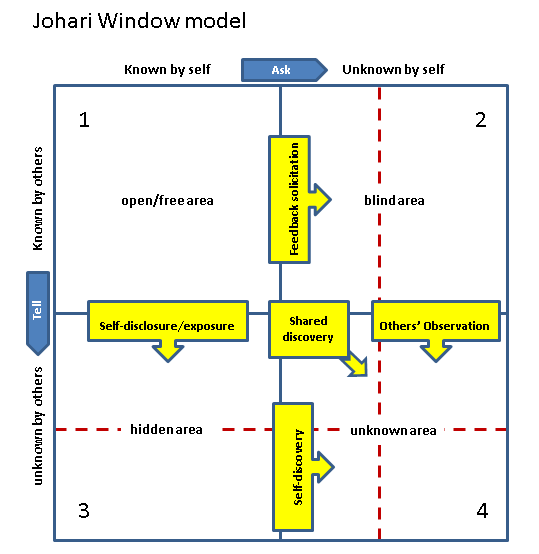The public pane (Pane 1) contains what is known to us and to other people. It is depicted in the Top Left of the diagram.

Pane 1 can be thought to be shared knowledge. When we communicate on a superficial level we use this Pane. In our day to day dealings with others this is usually quite sufficient.
However if we aspire to take up a role as a helper of others we need to increase our effectiveness in the area of communication. This is more important if we are helping people in acute distress – and wish to build a relationship based on genuineness, (congruence) trust and warmth.
Like a lot of other things I mention, (yes – you’ve guessed it) the work of some professionals who have a role as helpers (for example, teachers or nurses) will undoubtedly be enhanced by attending to effective communication, but it is an added bonus.
But for anyone who works with people in acute distress, on a long term basis, it is absolutely essential that effective communication is attended to continuously.
This is where good supervision comes in, because effective communication is enhanced when we work at increasing the size of Pane 1.
The way to increase the size of Pane 1, while decreasing the size of the other panes is through:
Self-disclosure: Self disclosure means sharing information about the real me with others and thus increasing their knowledge about me. (Have another look at the picture above). Self-disclosure is the yellow box with the arrow pointing down on the left-hand-side. When we self-disclose the red dotted line goes downward a little – meaning that people get to know us better as we have more open area and less hidden area.
And
Inviting feedback: Getting open and honest information about us from those who are close to us i.e. at work and elsewhere. This is the yellow box at the top with the arrow pointing to the right hand side. (I will refer to feedback again when I am describing Pane 2). Inviting feedback – or, indeed, listening to what others say about us or see in us causes the red dotted vertical line to move to the right, also widening Pane 1. That is, again, allowing others to get to know us better.
Self-disclosure has, of course, to have relevance and too much self-disclosure [1] is actually very unhelpful.
Appropriate self-disclosure, however, encourages feedback from others. The amount and quality of feedback we get is dependent on what vibes we give out about how open we are, i.e. to not only hearing the feedback but taking it on board and if necessary acting on it.
We
are continually receiving verbal and non-verbal information from others. How (or indeed if) we perceive this
information, and then act on it, determines the size of Pane 1.
[1]. The nature and extent of self-disclosure (and pondering on the appropriateness of it) is very good material for supervision.
